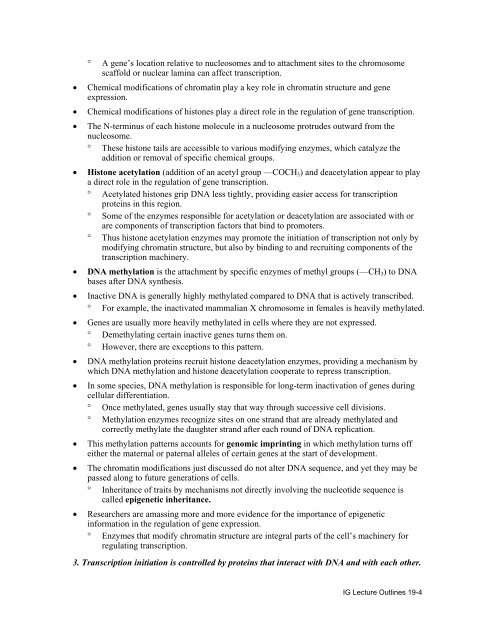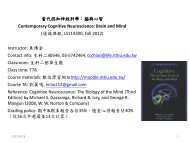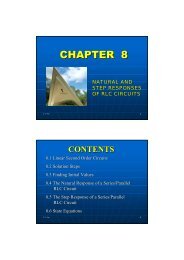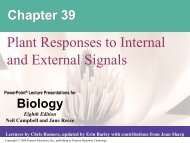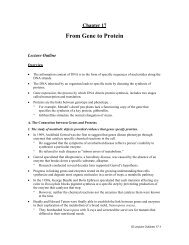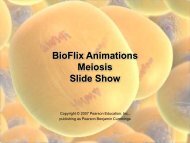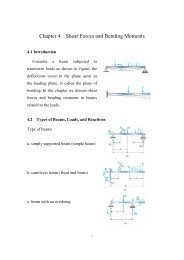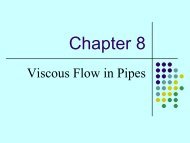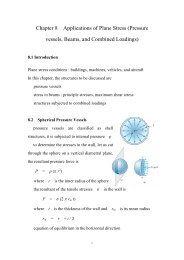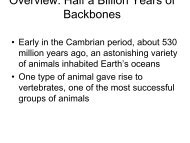chapter 19 the organization and control of eukaryotic genomes
chapter 19 the organization and control of eukaryotic genomes
chapter 19 the organization and control of eukaryotic genomes
Create successful ePaper yourself
Turn your PDF publications into a flip-book with our unique Google optimized e-Paper software.
° A gene’s location relative to nucleosomes <strong>and</strong> to attachment sites to <strong>the</strong> chromosomescaffold or nuclear lamina can affect transcription.• Chemical modifications <strong>of</strong> chromatin play a key role in chromatin structure <strong>and</strong> geneexpression.• Chemical modifications <strong>of</strong> histones play a direct role in <strong>the</strong> regulation <strong>of</strong> gene transcription.• The N-terminus <strong>of</strong> each histone molecule in a nucleosome protrudes outward from <strong>the</strong>nucleosome.° These histone tails are accessible to various modifying enzymes, which catalyze <strong>the</strong>addition or removal <strong>of</strong> specific chemical groups.• Histone acetylation (addition <strong>of</strong> an acetyl group —COCH 3 ) <strong>and</strong> deacetylation appear to playa direct role in <strong>the</strong> regulation <strong>of</strong> gene transcription.° Acetylated histones grip DNA less tightly, providing easier access for transcriptionproteins in this region.° Some <strong>of</strong> <strong>the</strong> enzymes responsible for acetylation or deacetylation are associated with orare components <strong>of</strong> transcription factors that bind to promoters.° Thus histone acetylation enzymes may promote <strong>the</strong> initiation <strong>of</strong> transcription not only bymodifying chromatin structure, but also by binding to <strong>and</strong> recruiting components <strong>of</strong> <strong>the</strong>transcription machinery.• DNA methylation is <strong>the</strong> attachment by specific enzymes <strong>of</strong> methyl groups (—CH 3 ) to DNAbases after DNA syn<strong>the</strong>sis.• Inactive DNA is generally highly methylated compared to DNA that is actively transcribed.° For example, <strong>the</strong> inactivated mammalian X chromosome in females is heavily methylated.• Genes are usually more heavily methylated in cells where <strong>the</strong>y are not expressed.° Demethylating certain inactive genes turns <strong>the</strong>m on.° However, <strong>the</strong>re are exceptions to this pattern.• DNA methylation proteins recruit histone deacetylation enzymes, providing a mechanism bywhich DNA methylation <strong>and</strong> histone deacetylation cooperate to repress transcription.• In some species, DNA methylation is responsible for long-term inactivation <strong>of</strong> genes duringcellular differentiation.° Once methylated, genes usually stay that way through successive cell divisions.° Methylation enzymes recognize sites on one str<strong>and</strong> that are already methylated <strong>and</strong>correctly methylate <strong>the</strong> daughter str<strong>and</strong> after each round <strong>of</strong> DNA replication.• This methylation patterns accounts for genomic imprinting in which methylation turns <strong>of</strong>fei<strong>the</strong>r <strong>the</strong> maternal or paternal alleles <strong>of</strong> certain genes at <strong>the</strong> start <strong>of</strong> development.• The chromatin modifications just discussed do not alter DNA sequence, <strong>and</strong> yet <strong>the</strong>y may bepassed along to future generations <strong>of</strong> cells.° Inheritance <strong>of</strong> traits by mechanisms not directly involving <strong>the</strong> nucleotide sequence iscalled epigenetic inheritance.• Researchers are amassing more <strong>and</strong> more evidence for <strong>the</strong> importance <strong>of</strong> epigeneticinformation in <strong>the</strong> regulation <strong>of</strong> gene expression.° Enzymes that modify chromatin structure are integral parts <strong>of</strong> <strong>the</strong> cell’s machinery forregulating transcription.3. Transcription initiation is <strong>control</strong>led by proteins that interact with DNA <strong>and</strong> with each o<strong>the</strong>r.IG Lecture Outlines <strong>19</strong>-4


